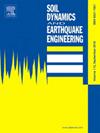Active tuned mass damper inerter with optimized fuzzy logic controller for structural seismic vibration mitigation
IF 4.2
2区 工程技术
Q1 ENGINEERING, GEOLOGICAL
引用次数: 0
Abstract
In this study, a smart inerter-based tuned mass damper (TMD) using an active technique is proposed wherein its fuzzy logic controller (FLC) is optimized through the genetic algorithm (GA). The uniqueness of the strategy lies in employing the GA to optimize the main parameters of the active FLC controller, aiming to enhance the structural seismic vibration mitigation performance of the passive TMD equipped with an inerter. First, the best control effect with practical feasibility among GA-optimized passive tuned mass damper inerter (PTMDI) layouts is discussed and determined, where it is installed between the last two consecutive floors, and the inerter is linked to the penultimate floor of the seismic vibrated structure. Later, active TMDI (ATMDI) with the same layout is proposed and analyzed in a primary structure excited by the seismic records and harmonic excitation. This clarifies the effect of the GA-optimizer on the design parameters of the FLC controller, the performance of the active methodology, as well as the key role of the inerter element in the configuration layout. The ATMDI is compared to the PTMDI, and an active TMD (ATMD) controlled by the same algorithm. The results show significantly improved responses using the ATMDI with lower additional mass than the ATMD. Finally, the simulation results demonstrate that the GA-FLC ATMDI, with the presence of an inerter element, can remarkably attenuate the seismic-induced motion in multi-story buildings with relatively simple design requirements.
求助全文
约1分钟内获得全文
求助全文
来源期刊

Soil Dynamics and Earthquake Engineering
工程技术-地球科学综合
CiteScore
7.50
自引率
15.00%
发文量
446
审稿时长
8 months
期刊介绍:
The journal aims to encourage and enhance the role of mechanics and other disciplines as they relate to earthquake engineering by providing opportunities for the publication of the work of applied mathematicians, engineers and other applied scientists involved in solving problems closely related to the field of earthquake engineering and geotechnical earthquake engineering.
Emphasis is placed on new concepts and techniques, but case histories will also be published if they enhance the presentation and understanding of new technical concepts.
 求助内容:
求助内容: 应助结果提醒方式:
应助结果提醒方式:


